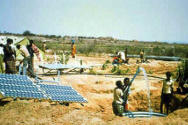
The next big leap Phone company Ericsson is partnering with an African cell-phone provider, to build a thousand solar-powered base stations across the continent this year. Nokia Siemens is also working on new base stations; it predicts that within two years, off-grid stations will become the standard in cell-phone-addicted Africa.
Traditional national grids can never serve all or even most Africans. In an indication of this changing mind-set, last year the World Bank, which typically funds large infrastructure projects, formed a coalition, with a budget of about $12 million, to fund dozens of tiny new projects offering new products and services based on off-grid electricity.
Lacking the billions of dollars necessary to expand creaky national electricity grids and build large power plants, Africa’s political and economic leaders are experimenting with alternatives. Electricity is increasingly being generated by microdams, solar cells, and microturbines. “Off-grid electricity could be the next great technological leap forward in Africa,” says Mark Hankins, a consultant in Nairobi who specializes in alternative power supplies.
In Kenya, one million households use car batteries as their main source of electricity. From Lagos to Nairobi, even the poorest slum dwellers are driven to purchase fuel that can create power to charge cell-phone batteries and provide light.
This week Greenpeace installed solar panels on the Senator Barack Obama School in Kogelo and on the roof of the house of Mama Sarah – the US President’s grandmother.
The barely credible Greenpeace press release alleged Mama Sarah said: “I am very pleased that my home has been improved thanks to solar energy and I’ll make sure my grandson hears about it. Solar power is clean, reliable and affordable, unlike paraffin that is widely used in the area. Also, we now have qualified youth in the village who can help with the upkeep of the systems.”
In all, more than half of Africans south of the Sahara–500 million people–aren’t connected to a national electricity grid and probably never will be. In some countries, such as Malawi and Congo, fewer than 10 percent of the people are connected to the national grid. Yet the demand is there: the World Bank estimates that Africans spend $40 billion a year on off-grid power.
One Response
We are looking at Micro-Grids here in ‘Ireland to make the most of local geography and potential local generation, that is generally overlooked on large scale modelling. Micro grids- local production and local use, making sense of geography.